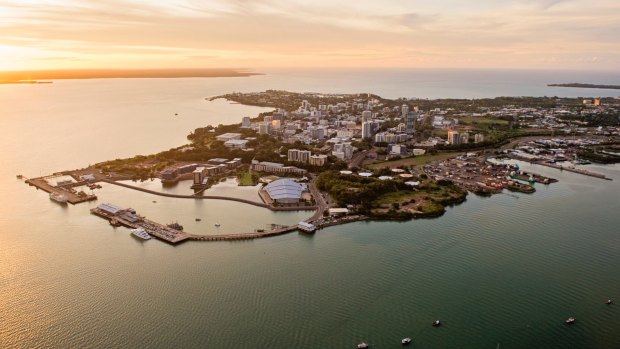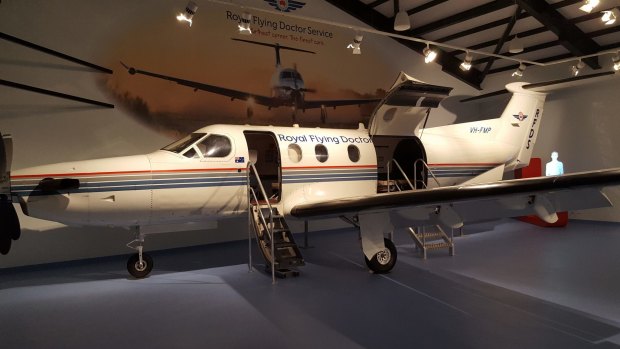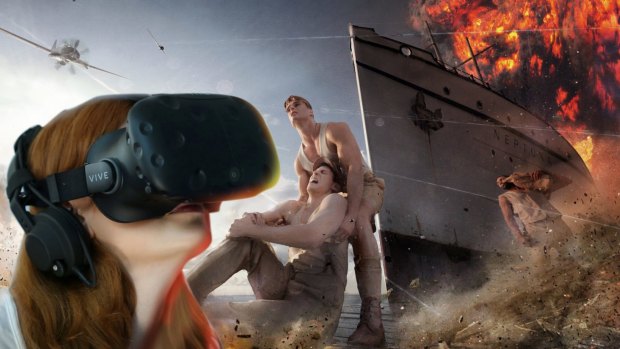This was published 5 years ago
Bombing of Darwin exhibition: Virtual-reality retells the day WWII arrived in Australia
By Brian Johnston

Darwin harbour.Credit: Shaana McNaught
It's a gentle start to an awful day, down on the wharf in Darwin harbour. I can hear the slopping of water against the ship's hull and the shriek of seagulls. Sunlight dances on white paintwork as I come up onto the deck of the Neptuna. A strange wasp-like buzzing from the sky makes me turn my head. Then from nowhere the bombs start to fall.
Spray shoots up and rocks the deck. Columns of black smoke billow. My fellow crewmen are blown overboard. Ships are on fire out on the harbour. Then suddenly I'm levitating, and I appear to be right inside a dogfight. Planes roar by. Glass and metal explode. Parachutes bloom. I'm falling back down and hit water murky with spilled oil and debris.
It's February 19, 1942, and this is the most significant wartime attack ever launched on Australian soil. More than 200 Japanese aircraft bombed Darwin, destroying ships and the city's waterfront and killing 235 people. The Bombing of Darwin exhibition occupies a building on Stokes Wharf, which bore the brunt of the attack. Traditional storyboards provide the details, but virtual-reality goggles bring your own Pearl Harbour to life.

A Royal Flying Doctor Service plane at the RFDS Darwin Tourist Facility.Credit: Tourism NT
It's only a reality of sorts, however. I find it easy to become absorbed in the technical cleverness of the virtual-reality experience, which at times feels like a video game. It's less gruesome than many video games. Nobody is blown apart, and bodies float decorously in the harbour. It's hard not to find the slow-motion sections beautiful, with their almost balletic sequences of flying debris, surprised sailors and wheeling squadrons of planes.
What is the purpose of a war museum? This is something you might ponder when you visit the Bombing of Darwin exhibition. Perhaps it should just provide straightforward information, or shock you with war's grim brutality, or goad you into patriotism. Maybe it should be entertaining, if only to catch your attention.
The exhibition's virtual-reality component is undoubtedly entertaining. Perhaps movies have inured us to war scenes. The most visceral reaction comes not from the images but the sound effects. I'm absorbed in my helmeted and goggled world. Planes drone, people shout, artillery fire rattles. I hear the wail of falling bombs get louder. When they explode, I can feel the reverberations in my chest. Perhaps it's the noise of war that is most terrifying.

Virtual-reality experience of the bombing of Darwin at the RFDS Darwin Tourist Facility.Credit: Tourism NT
The Bombing of Darwin exhibition, rather confusingly, sits inside the RFDS Darwin Tourist Facility, named for its other interesting – though far less compelling – exhibition on the Royal Flying Doctor Service. It backs up its virtual-reality immersion with plenty of well-presented information about this episode of World War Two, some presented the old-fashioned way with static displays.
The exhibition excels with its use of the latest technologies, however. A hologram of prime minister John Curtin answers questions selected from a touchscreen. Another hologram of fighter pilot Hajime Toyoshima provides a thought-provoking alternative. A full-size replica of his Zero aircraft hangs from the ceiling alongside a flying boat.
Best of all are the life-size holograms that animate documentaries in the theatre. The best features an actor playing Etheridge Grant, commanding officer of the USS William B Preston seaplane tender. Grant wasn't on board on the day of the bombing, having gone on shore to arrange for provisions, but his hologram relates the story of his attempts to return to the ship.
Grant was blown into the harbour and clung to a buoy as he dived to avoid bullets, bombs and burning oil. Eventually he swam ashore as the tide slackened. It's a neat piece of storytelling, strong on the human element while supplying good background on how that dreadful day unfolded.
TRIP NOTES
Brian Johnston was a guest of Tourism NT and Coral Expeditions.
MORE
traveller.com.au/northern-territory
FLY
Virgin and Qantas fly direct to Darwin from Sydney and Melbourne. See virginaustralia.com.au and qantas.com.au
STAY
Vibe Hotel Darwin Waterfront has large, pleasant rooms and a great location on Darwin's waterfront entertainment and dining hub. See vibehotels.com
TOUR
RFDS Darwin Tourist Facility covers the stories of the Bombing of Darwin and the Royal Flying Doctor Service. Adult entry $28, children $16. See rfdsdarwin.com.au
Sign up for the Traveller Deals newsletter
Get exclusive travel deals delivered straight to your inbox. Sign up now.